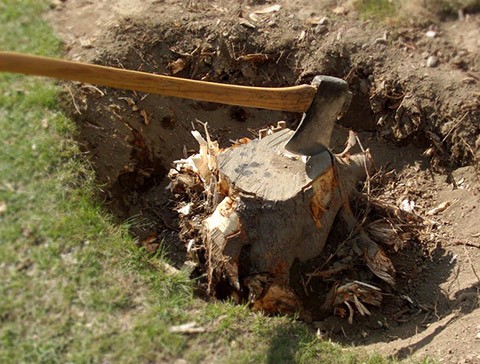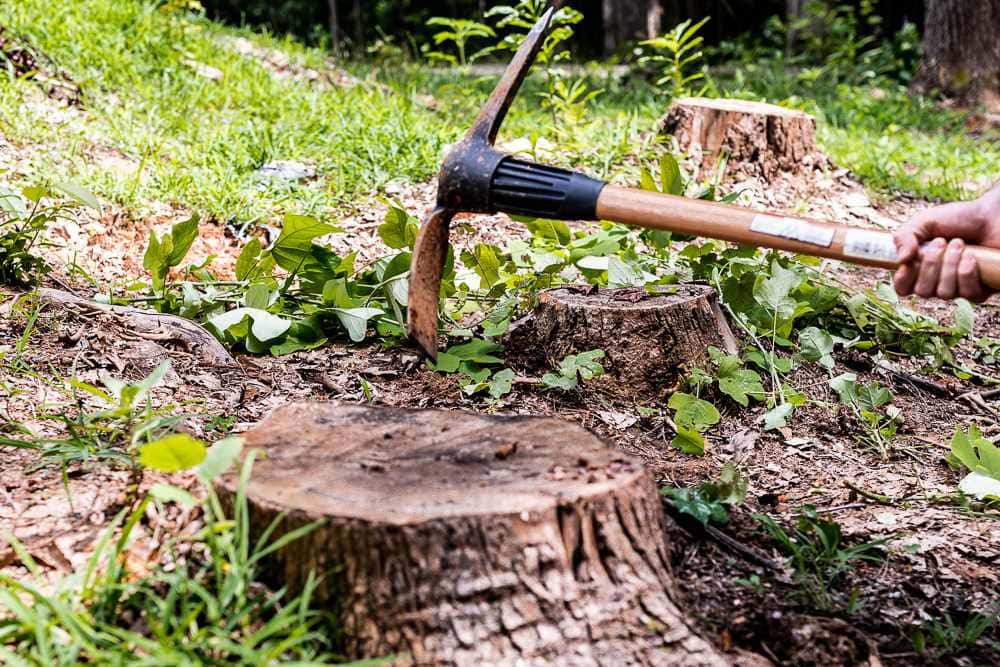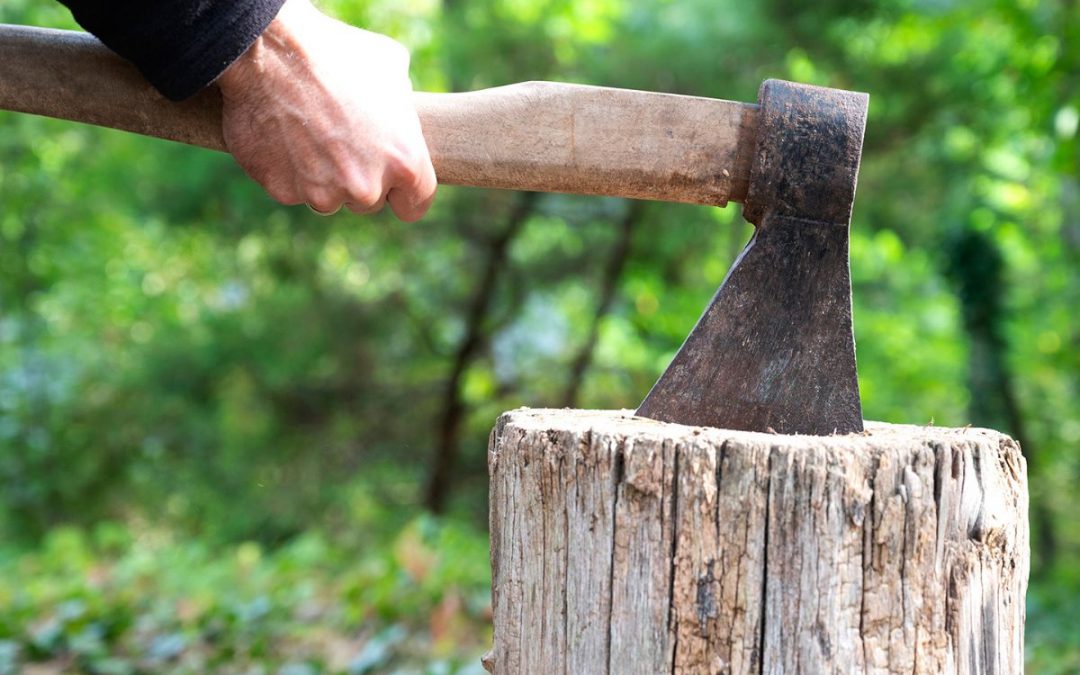There are several ways to do it yourself. First, you can cut out as much of the tree stump as possible. Then, drill holes into the remaining stump. After that, apply the chemicals and pour water into the holes. Depending on the type of tree stump, this can take several weeks.
Table of Contents
Cut down as much of the tree stump as you can
If you’re looking for a DIY tree stump removal project, there are several ways you can go about the process. One of the easiest is to drill a hole in the tree stump and fill it with potassium nitrate, a nitrogen fertilizer. Another option is to buy stump remover granules. You can also soak the ground in water before you remove the stump to help accelerate the rotting process.
Another way to kill a tree stump is to use Epsom salt. Epsom salt is a natural compound that contains magnesium, sulfur, and oxygen. It draws moisture out of the stump and kills it within a month. It’s also worth mentioning that you don’t want to use bleach, since it won’t kill the tree stump.
When you’re ready to tackle the project, prepare some heavy equipment. You’ll also need safety glasses and sawdust. If your tree stump is particularly large, you may want to consider hiring a professional.
Drill holes into the remainder of the stump
One of the easiest ways to dispose of tree stumps is to drill holes into them. Make sure to drill holes about three to four inches deep and space them at least three to four inches apart. To make the stump easier to remove, drill holes at a 45-degree angle. Next, pour the tree stump-rotting agent into the holes. This will cause the stump to rot and become spongy. After four to six weeks, the tree stump can be easily removed from the ground.
Once you have drilled the holes, use a drill bit that is at least an inch longer than the stump itself. Use a long bit to drill deeper holes. Once the hole is large enough, you can fill it with a high-nitrogen substance or water. After filling the holes, you can chip away the rest of the tree stump. Then, fill the holes with soil, if necessary.
You can use a gardening trowel to fill the holes with saltpeter or potassium nitrate. Once the saltpeter or potassium nitrate has dissolved, you can pour hot water into the holes. This will render the stump flammable.

Apply the chemicals
Fortunately, there are a variety of chemicals available to effectively remove tree stumps. Copper sulfate, for example, is a powerful chemical that also doubles as a potent herbicide. It is effective against algae, fungi, and even lawn grass.
The chemicals for stump removal are applied to the stump by either pouring it on or covering it with a plastic bag. Typically, the tree stump starts to die within two to four weeks, depending on its size. Once this happens, the stump is ready to be removed. It is also best to remove the stump before planting new shrubs or grass. A single bottle of chemicals will kill up to 16 tree stumps.
While it is possible to use these chemicals in order to remove tree stumps, you need to do your research and make sure they are safe for the environment. First, you need to choose a product that is specifically designed for your needs. There are some products that make false claims, and others may not work for all types of trees.
Pour water into the holes
To remove tree stumps without damaging your property, you may need to use boiling water to kill the tree roots. However, you must be sure to pour the water into the holes directly onto the roots. Alternatively, you can use gasoline or kerosene to soak the stump in and then ignite it.
Pouring water into the holes to remove tree stumps can be time consuming and requires patience. However, it is a very effective way to kill the tree stump by starving it of light. After a few weeks, the tree will rot completely, resulting in a stump that is not attractive to your garden.
Using hot water is another effective method for removing tree stumps. The water will kill the tree stump roots and make it easier to remove the tree. This method will take longer than other methods but will yield satisfactory results. However, you should consult your local fire department to determine whether there are any burning advisories in your area before you start the process.

Cover the stump
There are several methods to cover a tree stump for easy removal. Some methods involve covering the stump with a coffee can and kicking it hard. Covering the stump will help kill it more quickly, and it can also be an effective way to kill the roots that are keeping it from decomposing. Another method involves covering the stump with soil or mulch. This can take several months. After this time, you can simply remove the stump.
Tree stumps need light to survive. Covering them with black plastic is a good way to protect them from the sun. Leaving the stump exposed can starve the trees of their essential nutrients. This method is not advisable if the stump has seedlings. It can be harmful to wildlife.
Another option for removing a tree stump is by covering it with topsoil. This method can help you get rid of a stump without the hassle of hiring a professional. However, it may not be suited for all situations.
Soak the stump with kerosene
There are many different ways to get rid of tree stumps. One method involves filling up holes in the stump with Epsom salt. After a few weeks, the stump should begin to decay. The remaining pieces of the stump will look like crushed charcoal.
Another method involves using kerosene or diesel to burn the stump. However, this method has a high risk of fire, and you should use a fire extinguisher nearby. Moreover, burning a stump should only be used in areas that are not prone to wildfires.
Another way to get rid of a tree stump is to drill holes into it. Make sure to drill holes around 10 inches deep. Then, fill the holes with kerosene and let it soak in for 48 hours. You should be careful not to use gasoline or motor oil because these substances are very explosive and emit toxic smoke when burned.
Another way to remove tree stumps is by burning them. Kerosene can be mixed with a candle or kindling and lit over a fire. It is important to keep in mind that this method does not completely remove roots below the soil. However, it can yield satisfactory results and requires less physical exertion. However, it is important to check with your local fire department to see if there are any restrictions on burning in your area.
Set the stump on fire
Setting the stump on fire is a great way to remove tree stumps, but be sure to observe the entire process carefully and set a barricade to prevent people from walking over embers. Also, it is important to check your local community’s ordinances before starting a fire. Although most communities allow open burning, there are some that require a permit or have strict rules about removing tree stumps.
The first step in burning a tree stump is to carefully dig out the area around the stump. Make sure to leave a three-foot gap at the base. Then, you should fill the hole with charcoal or oil and set it on fire. If the stump is high, this step will take longer. However, by sawing the stump down close to the ground, you can cut down the time it takes to burn the stump.
Another way to remove a tree stump is to use kerosene or fuel oil. This fuel is easily absorbed by the wood, making it ideal for burning a tree stump. Once lit, the stump should smolder, so you can cover it with topsoil. In some neighborhoods, this method is not allowed, but it’s a simple, cheap way to get rid of tree stumps.
Fill the hole
There are several ways to remove tree stumps. The most effective way is to hire a professional, who will use the proper equipment and precision to remove the tree without damaging the surrounding land and plants. However, there are also some DIY methods. Here are some of them. You can use one of them if you are unable to hire a professional.
First, drill a hole large enough to accommodate the tree stump. Next, fill the hole with water or a high-nitrogen substance. This will soften the stump enough to be chipped off. After the stump is softened enough, fill the hole with soil and tamp it down. Repeat this step until the mound is one foot higher than the soil around it. After about six months, the mound will settle flat.
Next, fill the hole with water or a liquid fertilizer or a granular stump-remover product. Be careful with these chemicals, because they contain potassium nitrate, which is dangerous to the environment. Soak the granules thoroughly before using them. Also, you may want to cover the area with plastic tarp to retain moisture.

